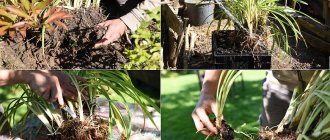Methods for propagating tree peony
Tree peonies are propagated by seeds and vegetatively:
- dividing the bush;
- cuttings;
- layering;
- vaccinations.
Vegetative propagation methods guarantee an exact copy (clone) of the mother plant. Dividing the bush is considered the simplest - you need to cut the rhizome with a knife and plant the divisions in a new place. A more complex method is propagation by seeds. In this case, the “children” may develop new signs. Some gardeners like to experiment, which allows them to diversify their flower garden.
Tree peonies can be propagated in any suitable way.
Brief description of the plant
Tree peony is a deciduous shrub, reaching up to 2 m in height, with erect, powerful stems. Large flowers are up to 17 cm in diameter. Their shape and color depend on the plant variety, which are divided into three groups:
- Sino-European have double flowers.
- Japanese - with non-double and semi-double flowers.
- Hybrids of yellow peony and Delaway peony have yellow flowers.
The varieties of the European group have large, heavy flowers and a variety of shades. Japanese varieties can be distinguished by smaller specimens growing on tall peduncles.
A distinctive feature of this species is that the number of flowers increases every year, and flowering occurs two weeks earlier than with a regular peony. This species also tolerates wintering well.
Rules for propagating tree peony by seeds
Propagation by seeds is considered the most labor-intensive method, since it consists of several stages - it is necessary to collect and prepare planting material, process it and plant it. However, all these processes can be carried out at home.
When to plant tree peony seeds
The fruits of the tree peony are small seed pods that appear in mid-August.
The collection of seed material begins at the end of September, during this period the boxes begin to open
First, the seeds should be dried for several days, and they can be planted in early October (in Siberia and the Urals the dates are shifted to mid-September).
Selection of containers and soil preparation
Seeds of tree peonies are grown in open ground, but this can also be done at home, followed by transfer to open ground. Any containers for seedlings, small cups or pots will do.
The soil must be fertile and loose. You can purchase a special composition for seedlings or mix garden soil (1 part) with humus (1 part), add peat (2 parts) and sand (1/2 part).
Attention! It is better to pre-disinfect the mixture by keeping it in a weak solution of potassium permanganate for several hours.
How to plant tree peony seeds
Tree peony seeds can be sown both in open ground and in small containers. In the first case, they are transplanted into fertile soil to a shallow depth of up to 3 cm. It is best to take a wooden box, dig it in and bury the seeds in it. The soil is dug up and moistened in advance. For the winter, seedlings must be mulched. In March, the box can be kept at home for several weeks, and in April it can be taken out into the open ground again. Shoots will appear this spring.
When propagated at home, the seeds are first sprinkled with damp peat and stored at room temperature until early February. At this moment they are transferred to the refrigerator, on a shelf with vegetables (temperature 5-8°C) and kept there until mid-May. Then they are sown in open ground to a depth of 5 cm. The first shoots will appear in the same summer.
How to grow tree peony from seeds
Special care should be taken for emerging sprouts:
- provide stable hydration;
- feed 2-3 times (nitrogen in spring, superphosphate and potassium salt in summer);
- for the winter, mulch with peat, dry leaves, and cover with spruce branches.
After wintering, tree peonies can be transplanted to a permanent location.
Important! In the second year, the bushes may produce flower stalks with the first buds; it is better to tear them off, since the peonies must get stronger before flowering in the next season.
How to plant a tree peony correctly: replanting an adult bush
To transplant an adult tree peony bush (8-15 years old), prepare the holes 2-4 weeks in advance so that the soil settles. If you are making a hole just before planting, compact the soil. The distance between pits is at least 1.5 m.
If the groundwater is below 2 m, then to transplant an adult bush (8 years or more), dig a hole in the form of a cone, with a depth and an upper diameter of about 70 cm. Place 15-20 cm of drainage (gravel, broken brick) on the bottom of the hole. - rotted manure; on acidic soils, add 200 g of lime.
When transplanting, dig up the bush along with a lump of earth. Stick the shovel at a distance of 30-35 cm from the stems so as not to damage the small suction roots. To prevent the earthen lump from crumbling, wrap it in gauze and plant the bush directly with it. If you bought a large plant at a nursery, then when transporting it, put it together with a ball of earth wrapped in gauze in a box so as not to injure the roots.
Pour soil into the hole in a heap, place the plant on it along with a lump of earth and immediately fill it with plenty of water so that all the roots spread out. After about twenty minutes, when the moisture has been absorbed, fill the hole with prepared soil. Do not trample the ground around the bush.
If groundwater lies close to the surface, plant the plant on a mound.
In early October, mulch the tree trunk with peat or a mixture of peat and humus. The first year after transplantation, the plant, as a rule, is sick and grows in growth, sometimes almost all the shoots may seem completely withered. But do not rush to write it off as a waste - by the end of the growing season, new shoots will appear from the adventitious buds located at the base of the stems and natural rejuvenation of the bush will occur.
Watch the video of planting a tree peony to better imagine how this agrotechnical activity is performed:
Tree peony cuttings
Cuttings are one of the most accessible methods of propagating tree peony. It is advisable to harvest cuttings from those bushes that are 4-5 years old.
Timing for propagation of tree peony by cuttings
You can prepare cuttings for propagating tree peony at the very beginning of summer. If the deadline has passed, it is better to wait until the next season or divide the bush, otherwise the cuttings will not have time to grow and take root in the open ground.
Cutting and preparing planting material
To obtain a cutting, take a sharp knife and disinfect the blade. Several cuttings are cut from the middle part of the branches. Each of them must have at least 2 internodes. Make the top cut 1-2 cm above the last leaf.
The lower oblique cut is made directly under the base of the leaf
Keep the cuttings in a root growth stimulator solution for 3-4 hours.
Rooting tree peony cuttings
For rooting, it is necessary to prepare a soil mixture from the following components:
- turf soil - 1 part;
- humus – 1 part;
- sand – 0.5 parts.
You only need to mix the soil with humus - they are poured directly onto the open ground (in a small hole) and moistened. Sand is added on top with a layer of 5-6 cm and watered again.
Planting cuttings
The cuttings are planted in the resulting mixture at an angle of 45°. Then they are covered with film, they are grown for a month, periodically airing. At the end of August the film is finally removed. In September, sprouted tree peony cuttings are mulched with peat, straw or spruce branches. After 2-3 years they can be transplanted to a permanent place.
Difference from the herbaceous species
The first and main difference can be called its powerful shoots with its characteristic leaves. If in the herbaceous species the shoots die off with the onset of cold weather, then in the tree-like species they only grow, due to which it becomes spherical every year and can grow up to 2 meters. The foliage is shed in the fall, but the stems only become stronger.
The plant does not need to cut off the buds for the next flowering. This only works with the herbaceous species. Peony is similar to cold-resistant roses and tolerates winter well, but if the frosts are severe, you need to take care of its protection.
If the plant is located in the right place and feels comfortable, it can bloom for about 4 weeks . And its flowering is also affected by the temperature in the area where it lives. If the plant is not replanted, it can grow for decades. Some bloom for 20-30 years and you can find plants with up to 100 flowers.
The downside is that flowering can be observed only after 4 years after planting in open ground. First, one flower appears, and only then, over time, the bush gains color and grows shoots. In the first years it may seem that the bush has stopped growing, but this is normal and only after 5 years will it begin to gain weight and grow.
If we briefly describe their differences, we get the following parameters :
- plant height;
- flower diameter;
- some disadvantages and differences in care;
- escape power.
In order for the bush to begin to bloom, its height should be about 60 cm in height.
Reproduction of tree peony by layering
To obtain layering from a tree peony, choose relatively young bushes aged 3-4 years or older. Reproduction begins in May (in the southern regions - at the end of April), and the process ends in early September.
Sequencing:
- Choose a powerful bush with developed lower shoots.
- One of the branches is carefully bent to the ground and secured with pins, wire or other available means.
- Sprinkle with soil. The branch should be under the soil layer.
- Water along the shoot.
In the future, there is no need to specially care for this branch, since it will receive the necessary nutrients from the mother bush. It is advisable to additionally water and mulch the soil so that it retains moisture longer.
By the beginning of September, the shoot will take root in several places, i.e. This method of propagating a tree peony guarantees the appearance of at least two layerings. They are carefully separated using a sharp knife, the cut points are sprinkled with charcoal, and then planted in a permanent or temporary area.
Full-fledged bushes from cuttings will grow in 3-4 years
Features and timing of transplantation
The most risky undertaking is spring peony transplantation. Many gardeners do not recommend it at all, believing that it will greatly weaken or even destroy the plant. There are important nuances here:
- you need to do it before the air warms up to 10°C and the soil warms up to 3°C (then the peonies start to grow);
- In spring you can’t divide the bushes;
- in the summer, the peony will greatly slow down in growth and will not bloom - the buds, if they appear, will have to be removed, giving the plant the opportunity to direct all its forces to the formation of roots (specimens transplanted in spring bloom 2-3 years after the procedure).
In central Russia and Belarus, spring transplantation of peonies occurs in the first half of April, in the Urals and Siberia - in the second or early May. In the southern regions and Ukraine, suitable weather sets in at the end of March.
Video: spring transplantation of peonies
In summer, peonies can be replanted in the last ten days of August. By this time the heat has already subsided, more frequent precipitation saturates the soil with moisture. All this makes it easier for the bushes to adapt. Before frost, new plants (peonies can be divided) will have time to take root and prepare for winter. Replanting during flowering and budding is a reliable way to ruin the bushes.
When a peony begins its active growing season, and even more so when it gains color and blooms, replanting is categorically excluded.
In the fall (September-October), replanting a peony is as painless as possible. The roots and above-ground parts freeze in development, the plant enters a dormant stage, weakly reacting to any manipulation, including division. The specific timing of transplantation depends on the region. There should be at least 30–40 days until the first frost:
- central Russia, Northwestern region, Belarus - 20.08–25.09;
- Ural, Siberia, Far East - 20.08–10.09;
- south of Russia, Ukraine - 01.09–15.10.
The most common herbaceous peonies are replanted on average once every 10 years. Wild varieties can live in one place longer, up to 50 years. Ito hybrids and tree peonies require special care. They are moved to a new place only in case of extreme need - the roots of such plants are fragile and long (up to 80 cm), and are easily damaged when digging the bushes out of the soil. Peonies older than 5 years are suitable for division.
Ito peonies tolerate replanting worse than ordinary herbaceous peonies, so for them this procedure is carried out only in case of emergency
Propagation of tree peony by dividing the bush
Propagation of tree peony by dividing the bush is considered the simplest and at the same time effective method, ensuring almost 100% survival rate of the divisions. The procedure is recommended only for adult plants that are at least five years old. It is better to start propagation in early September, i.e. at least 1 month before the onset of the first frosts on the soil.
Before propagating the tree peony, it is necessary to prepare the tools - sharpen the shovel and disinfect the knife blade in potassium permanganate or an alcohol-containing solution.
If the bush has grown greatly, all lower shoots are shortened with pruning shears by 1/3 or half so that they do not break during propagation. Use a shovel to cut out the soil around the peony and dig up the bush. Remove the soil by hand and wash it off with water so that the rhizomes can be clearly seen.
Using a knife, divide the rhizome.
Each division should have 2-3 healthy shoots
The sections are sprinkled with ash, charcoal or a weak solution of potassium permanganate (concentration 1-2%). The bush is returned to its place. It can be watered additionally, but it cannot be fed - at the beginning of September, the tree peony is already preparing for the winter period.
If possible, it is better to soak each section of tree peony for 30-40 minutes in a mixture of clay and water. Then plant at a distance of 40-50 cm or more (depending on the characteristics of the variety).
The cuttings are planted in pre-prepared holes, and the root collar should remain 3-4 cm above the surface. A mixture of humus and garden soil can be added to the planting hole in equal quantities, then watered abundantly.
When is the best time to replant tree peonies? In spring or autumn?
We recommend replanting flowers from August 20th to September 30th. The main thing is to have time to replant 30-40 days before the onset of frost. The fact is that by autumn the root system of the flower develops well, and it becomes stronger and also remains dormant.
Transplantation dates in autumn
Replant peonies from mid-August or fall depending on your climate zone.
- Siberia, Ural - from August 20 to September 15-20.
- North-west, Moscow region, Middle zone - from August 25 to September 25.
- Southern Russia and Ukraine – from September 1st to September 30th.
The deadline for transplantation is the end of September, before suction roots have formed.
Caring for tree peony after transplantation
Care after transplantation consists of preparing the seedlings for winter: cover with a 10-14 cm layer of peat. In spring, the mulch is raked to the sides and standard plant care begins.
Next fall, it is also better to cover the bush for the winter.
See the article on planting for more details - chapter “Care for peonies after planting.”
First year after transplant
Peony next year often has most of its shoots in a dried-out state. At the same time, the leaves are often small and slightly wilted, but the main thing is that the upper buds of the shoots are alive. But after a year the seedling adapts and begins to grow.
In the first year, it is important to water well and feed the flower on time. This way we increase the chances of adaptation and successful wintering of the bush.
When will peonies bloom after transplanting?
The bushes bloom after transplantation, usually in the 4th-6th year.
For the preparation and process of the first flowering, see the article on care and cultivation. They are different from herbaceous varieties.
How to propagate a tree peony by grafting
As a rule, propagation by grafting is used if other methods (dividing the bush, cuttings or obtaining layering) have failed. Tree peony is grafted onto shoots of any herbaceous variety. It is better to reproduce in late May - early June.
Many gardeners believe that propagating tree peonies by grafting is a very complicated process, although in fact the procedure is not difficult. The procedure is carried out as follows:
- Take the top shoot from the peony (not the peduncle, but an ordinary branch) and make a cut so that 3-4 buds remain. It must be done at an acute angle so that the surface area is large enough. It is advisable to do it in one sharp movement. The result will be a scion - a branch that will be grafted onto an adult bush (rootstock) for further growth. Cut shoots can be placed on a clean cloth or in a bag.
- It is necessary to treat the rootstock - this is the middle part of the stem with one leaf and a well-developed bud. A straight cut is made, and then a cleft is made, the parameters of which are adjusted to the scion.
- The next step is to insert the scion into the crevice of the rootstock.
- The structure must be secured with grafting tape, which can be purchased at a specialized store.
- The next stage of tree peony propagation is immersing the rootstock in a solution of “Epin”, “Kornevin” or another root growth stimulator for several hours. Then rooting is carried out in fertile soil (you can choose any container).
- Water generously, and if excess moisture remains, remove it with a cloth or napkin. Cover with a dark cap and keep at room temperature until the scion fuses with the rootstock.
- The last stage of propagation is transplanting the tree peony to a permanent place. This must be done exactly in a year. During this time, the cuttings are grown at home as a regular houseplant.
Important! You cannot handle the sections with your hands - it is necessary to maintain sterility
Selection of seedlings
When purchasing, you should distinguish between grafted and rooted varieties. The essence of grafting is to combine a mature root system with a young cutting. Thus, the peony grows much faster, blooms already in the year of planting, and produces large growths (up to half a meter of shoots). Self-rooted ones sometimes wait up to 5 years for the first inflorescence to appear.
A clear advantage of self-rooted individuals is viability. Due to their slow development, they manage to gain strength to withstand diseases and weather conditions for decades. Grafted peonies often devote all their strength to the roots, so the stems quickly become hollow, rot and die.
Grafted individuals cannot be propagated by simple division; they must be immediately planted in a permanent place. Own roots are not vagaries in dividing and replanting.
To ensure that the garden delights with its beauty from the first season, both types are combined. While some are blooming, others are gaining strength for the future.
Planting care
Caring for tree peony plantings is not difficult.
- seedlings are regularly watered or moistened with a spray bottle so that the soil remains consistently moist;
- at the end of summer, superphosphate and potassium salt are added - this mixture will allow you to successfully survive the winter;
- cover with spruce branches, peat or improvised materials;
Attention! In early April (after the snow melts), the mulch is removed so that the cuttings of the tree peony do not rot. In the future, they are cared for in the same way as adult plants: regular watering is provided and fertilizers are applied at least 3 times per season: in spring (nitrogen), at the beginning and end of summer (superphosphates and potassium salt). For the winter, mulching is carried out (in the southern regions the procedure is optional).
Planting and care
Tree peony begins to be planted in the spring, after the ground has warmed up well, or in early autumn. On the site, choose a place protected from strong winds and drafts. It should also be protected from direct sunlight. The location should be chosen carefully, as peonies do not tolerate transplantation well.
Peony planting technology
Be sure to prepare the soil before planting a peony tree. Caring for the plant will become easier if it is planted in fertile and loose soil. To do this, prepare a mixture of turf or leaf soil, sand and rotted compost. If the soil is highly acidic, lime or wood ash is added to it. In order to grow a strong and healthy plant, you must follow all the rules of agricultural technology.
Before planting young plants, dig holes up to 70 cm deep two weeks in advance. A drainage layer of broken brick or crushed stone is laid at the bottom of each hole. A layer of prepared fertile mixture is poured onto the drainage. Then the seedling is carefully lowered and the roots are aligned. Fill the voids with soil and water generously. Mulch is poured around the plantings using peat or straw.
Growing and care
The tree peony must be properly cared for after planting. There are a number of activities for this:
- watering;
- feeding;
- pruning;
- preparation for winter.
Since the plant does not like too wet soil, it is therefore watered twice a month, pouring a bucket of water under each bush. During the dry season, the amount of watering is increased, and in the rainy season, it will be enough to loosen the soil around the bushes. During the period of active growth of peonies, they are fed with fertilizers containing nitrogen. During the flowering period, potassium and phosphorus are added to plants. After flowering, the bushes are fed with a mixture of bone meal and wood ash.
In the spring, gardeners carry out sanitary pruning, removing damaged and frozen branches. At the same time, the formation of bushes is carried out. Particular attention is paid to pruning tree peony in the fall. The first procedure is carried out immediately after flowering, removing dried flowers, while leaving the foliage untouched. During this period, the process of photosynthesis still continues, which allows the root system to accumulate useful substances. Which, in turn, help the plant survive the winter safely.
The second pruning in the fall is carried out after the first frost, when the plant is completely free of foliage.
Preparing them for the winter period is of great importance for the preservation of shrubs. Although the plant is considered frost-resistant, experienced gardeners still recommend protecting the tree peony from frost. Shelter for the winter is carried out at the end of October. To do this, the branches are collected in a heap and tied with a rope. Then you should cover the lower part of the trunk with peat mulch. The bush itself is covered with spruce branches, tree bark, and you can also use jute bags.
In conclusion, it is worth noting that the most effective way to propagate a plant is to divide the bush, since the simplest method of cuttings does not give the desired productivity. And also when caring for the plant, special attention should be paid to autumn pruning and preparing it for winter.
How to replant peonies correctly
Well-lit places protected from drafts are optimal for peonies. Lowlands are unsuitable for these plants - in the spring, melt water stagnates there, and the rest of the time - rain and damp, humid air.
Transplanting peonies is preceded by preparing the planting hole. This needs to be done 2-3 weeks before the procedure if you plan to transplant in the spring, or even last fall. The depth and diameter of the hole is 60–70 cm (with the exception of bushes after division, it should be shallower).
The roots of the peony are developed, but quite fragile - they are easily damaged during the transplantation process.
Any drainage material is poured into the bottom (layer 4–5 cm thick), then the hole is half filled with humus or ready-made compost. The top layer is turf soil previously removed from the pit, mixed with 100 g of simple superphosphate and 25 g of iron sulfate (or with 40–50 g of fertilizer for ornamental flowering plants). If the acidity of the substrate is high, add another 100 g of dolomite flour or ground eggshells.
A drainage layer at the bottom of the planting hole will prevent water from stagnating at the peony roots, thereby preventing the development of rot
To remove a peony from the soil, they dig it in with a pitchfork in a circle, stepping back 30–50 cm from the base of the bush (the older the bush, the more branched its roots), the soil in the tree trunk circle is carefully loosened. Then gently shake them to the sides, holding them by the lower part of the stems.
You cannot sharply tug or pull the plant towards you - most of the root system will remain in the soil. Remove the earthen ball from the soil using two shovels.
To pull a peony bush out of the ground with minimal losses, first dig it in with a pitchfork (this way there is less risk of damaging the roots), then gently swing it to the sides
When a peony is removed from the ground, the roots are washed and inspected, if necessary, cutting off dry, rotten, moldy, or insect-damaged areas with a sharp, disinfected knife. The sections are immediately washed with 2% copper sulfate (or a solution of any other fungicide prepared according to the instructions), sprinkled with crushed chalk, ash, or smeared with brilliant green. The plant is planted, allowing it to lie in the shade for 2-3 hours - during this time, excess moisture leaves the roots, they become softer and less fragile.
For a peony extracted from the soil, you need to wash off the soil from the roots with a stream of water with not too strong pressure and inspect them for damage.
There is nothing complicated about the transplant itself. The peony roots are placed in the center of the planting hole, collecting the soil into a small mound. Then it is covered with earth and watered, using 20–25 liters of water. Mulch the soil, shade the plant by placing a canopy of any white covering material over the bush, and leave it alone for 2 weeks.
If the peony needs to be divided:
- Using a sharp pruner with disinfected blades or a knife, cut it at the base into several parts (usually 2-4 sections) so that each has 3-5 growth buds. The length of the rhizome is 8–12 cm; it must have 3–4 adventitious roots, at least 5 cm long. Larger sections should not be used; they take longer to take root.
Both very large and very small parts of the peony bush take longer and worse to take root in the new place after division.
Soaking in a fungicide solution is necessary for disinfection; the biostimulator activates the root formation process and minimizes the stress suffered by the plant
Planting peonies after dividing the bush to a new place is a simple procedure that even a novice gardener can handle.
The transplanted peony must be watered and mulched so that the moisture does not evaporate from the soil too quickly











